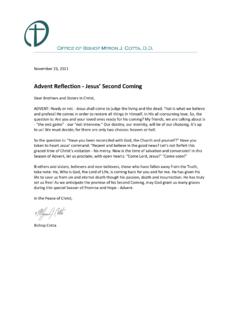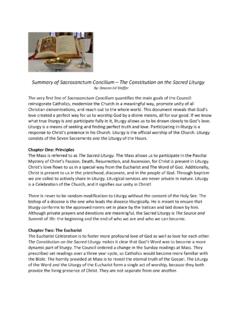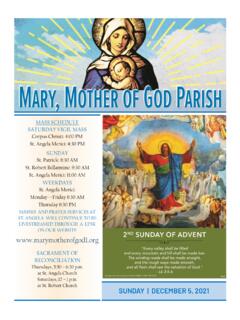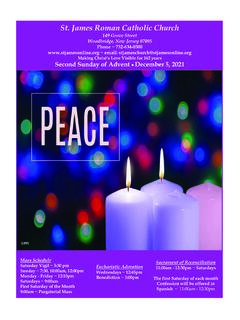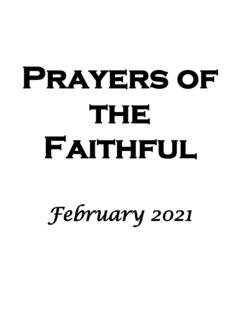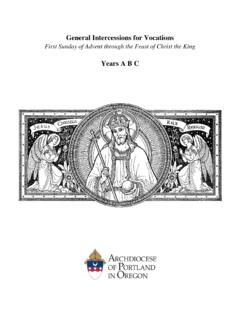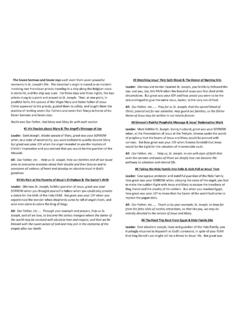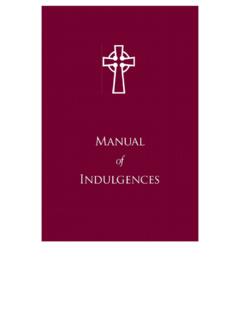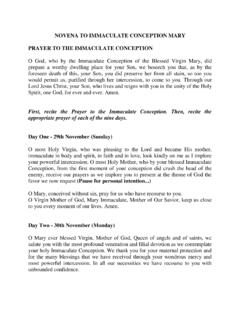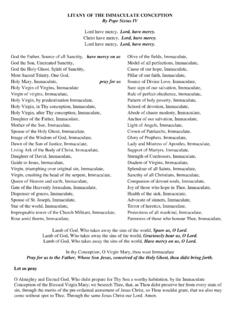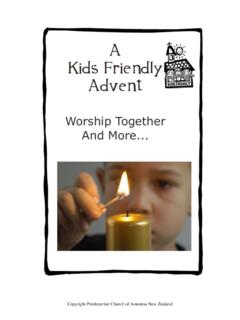Transcription of The Meaning of Advent - St. Charles Borromeo Catholic Church
1 The Meaning of " Advent " The word Advent means "coming" or "arrival." The focus of the entire season is the celebration of the birth of Jesus the Christ in his First Advent , and the anticipation of the return of Christ the King in his Second Advent . Thus, Advent is far more than simply marking a 2,000 year old event in history. It is celebrating a truth about God, the revelation of God in Christ whereby all of creation might be reconciled to God. That is a process in which we now participate, and the consummation of which we anticipate. Scripture reading for Advent will reflect this emphasis on the Second Advent , including themes of accountability for faithfulness at His coming, judgment on sin, and the hope of eternal life. In this double focus on past and future, Advent also symbolizes the spiritual journey of individuals and a congregation, as they affirm that Christ has come, that He is present in the world today, and that He will come again in power. That acknowledgment provides a basis for Kingdom ethics, for holy living arising from a profound sense that we live "between the times" and are called to be faithful stewards of what is entrusted to us as God s people.
2 So, as the Church celebrates God s inbreaking into history in the Incarnation, and anticipates a future consummation to that history for which "all creation is groaning awaiting its redemption," it also confesses its own responsibility as a people commissioned to "love the Lord your God with all your heart" and to "love your neighbor as yourself." The Spirit of Advent Advent is marked by a spirit of expectation, of anticipation, of preparation, of longing. There is a yearning for deliverance from the evils of the world, first expressed by Israelite slaves in Egypt as they cried out from their bitter oppression. It is the cry of those who have experienced the tyranny of injustice in a world under the curse of sin, and yet who have hope of deliverance by a God who has heard the cries of oppressed slaves and brought deliverance! It is that hope, however faint at times, and that God, however distant He sometimes seems, which brings to the world the anticipation of a King who will rule with truth and justice and righteousness over His people and in His creation.
3 It is that hope that once anticipated, and now anticipates anew, the reign of an Anointed One, a Messiah, who will bring peace and justice and righteousness to the world. Part of the expectation also anticipates a judgment on sin and a calling of the world to accountability before God. We long for God to come and set the world right! Yet, as the prophet Amos warned, the expectation of a coming judgment at the "Day of the Lord" may not be the day of light that we might want, because the penetrating light of God s judgment on sin will shine just as brightly on God s people. Because of this important truth, especially in the Eastern Orthodox Churches, the Season of Advent has been a time of fasting and penitence for sins similar to the Season of Lent. However, a different emphasis for the season of Advent has gradually unfolded in much of the rest of the Church . The season of Advent has come to be celebrated more in terms of expectation or anticipation. Yet, the anticipation of the Coming of the Messiah throughout the Old Testament and Judaism was not in connection with remembrance of sins.
4 Rather, it was in the context of oppression and injustice, the longing for redemption, not from personal guilt and sin but from the systemic evil of the world expressed in evil empires and tyrants. It is in that sense that all creation groans for its redemption as we witness the evil that so dominates our world (Rom 8:18-25). Of course, there is the problem of longing for vindication from an evil world when we are contributors to that evil. This is the power of the images of Amos when he warns about longing for the "Day of the Lord" that will really be a day of darkness (Amos 5:18-20). Still, even with Amos warning the time of Advent is one of expectation and anticipation, a longing for God's actions to restore all things and vindicate the righteous. This is why during Advent we as Christians also anticipate the Second Coming as a twin theme of the season. So, while some Church traditions focus on penitence during Advent , and there remains a place for that, the spirit of that expectation from the Old Testament is better captured with a joyous sense of expectancy.
5 Rather than a time of mourning and fasting, Advent is celebrated as a time of joy and happiness as we await the coming of the King. There will be time enough during the rest of the journey through the Church Year to remember our sins. It begins in Epiphany when we hear about the brotherhood of the Kingdom, and realize our failure to affect it. Then as we move toward and through Lent we realize that the coming of Jesus served more to lay bare our own sin than it did to vindicate our righteousness. There will be time to shed Peter's bitter tears as we realize that what started with such possibility and expectation has apparently ended in such failure. It is only as we experience that full cycle, beginning with unbridled joy in Advent that slowly fades into the realization of what we have done with and to the Christ, that the awful reality of Good Friday can have its full impact. And in that realization we can finally be ready to hear the Good News on Resurrection Sunday! That is the journey that the disciples took.
6 And so there is value in taking the same journey beginning with the anticipation and joy of Advent ! So, we celebrate with gladness the great promise in the Advent , yet knowing that there is also a somber tone as the theme of threat is added to the theme of promise. This is reflected in some of the Scripture readings for Advent , in which there is a strong prophetic tone of accountability and judgment on sin. But this is also faithful to the role of the Coming King who comes to rule, save, and judge the world. Because of the dual themes of threat and promise, Advent is a time of preparation that is marked by prayer. While Lent is characterized by fasting and a spirit of penitence, Advent s prayers are prayers of humble devotion and commitment, prayers of submission, prayers for deliverance, prayers from those walking in darkness who are awaiting and anticipating a great light (Isa 9)! The spirit of Advent is expressed well in the parable of the bridesmaids who are anxiously awaiting the coming of the Bridegroom (Matt 25:1-13).
7 There is profound joy at the Bridegroom s expected coming. And yet a warning of the need for preparation echoes through the parable. But even then, the prayer of Advent is still: Come, O Come, Emmanuel, And ransom captive Israel! The Colors of Advent Historically, the primary sanctuary color of Advent is Purple. This is the color of penitence and fasting as well as the color of royalty to welcome the Advent of the King. Purple is still used in some traditions (for example Roman Catholic ). The purple of Advent is also the color of suffering used during Lent and Holy Week. This points to an important connection between Jesus birth and death. The nativity, the Incarnation, cannot be separated from the crucifixion. The purpose of Jesus coming into the world, of the "Word made flesh" and dwelling among us, is to reveal God and His grace to the world through Jesus life and teaching, but also through his suffering, death, and resurrection. To reflect this emphasis, originally Advent was a time of penitence and fasting, much as the Season of Lent and so shared the color of Lent.
8 In the four weeks of Advent the third Sunday came to be a time of rejoicing that the fasting was almost over (in some traditions it is called Gaudete Sunday, from the Latin word for "rejoice"). The shift from the purple of the Season to pink or rose for the third Sunday Advent candles reflected this lessening emphasis on penitence as attention turned more to celebration of the season. In recent times, however, Advent has undergone a shift in emphasis, reflected in a change of colors used in many churches. Except in the Eastern churches, the penitential aspect of the Season has been almost totally replaced by an emphasis on hope and anticipation. This does not eliminate any sense of penitence from the Season. With the focus on the Advent or Coming of Jesus, especially in anticipating His Second Advent , there remains a need for preparation for that coming. Most liturgical churches incorporate confessional prayers into the services of Advent that relate to a sense of unworthiness as we anticipate His Coming.
9 It is appropriate even in more traditional services of worship to incorporate confessional prayers as part of the anticipation and preparation of the Season. With the shift to blue for Advent in most non- Catholic churches, some churches retain pink among the Advent colors, but use it on the Fourth Sunday of Advent . It still remains associated with Joy, but is sometimes used as the climax of the Advent Season on the last Sunday before Christmas. Red and Green are more secular colors of Christmas. They derive from older European practices of using evergreens and holly to symbolize ongoing life and hope that Christ s birth brings into a cold world. Although red and green are often used as part of the Church decorations (see below), they are never used as liturgical colors during Advent since those colors have other uses in other parts of the Church year. Evergreens and the Advent wreath The beginning of Advent is a time for the hanging of the green, decoration of the Church with evergreen wreaths, boughs, or trees that help to symbolize the new and everlasting life brought through Jesus the Christ.
10 Some churches have a special weekday service, or the first Sunday evening of Advent , or even the first Sunday morning of Advent , in which the Church is decorated and the Advent wreath put in place. This service is most often primarily of music, especially choir and hand bells, and Scripture reading, along with an explanation of the various symbols as they are placed in the sanctuary. The Advent wreath is an increasingly popular symbol of the beginning of the Church year in many churches as well as homes. It is a circular evergreen wreath (real or artificial) with five candles, four around the wreath and one in the center. Since the wreath is symbolic and a vehicle to tell the Christmas story, there are various ways to understand the symbolism. The exact Meaning given to the various aspects of the wreath is not as important as the story to which it invites us to listen, and participate. The circle of the wreath reminds us of God Himself, His eternity and endless mercy, which has no beginning or end.
